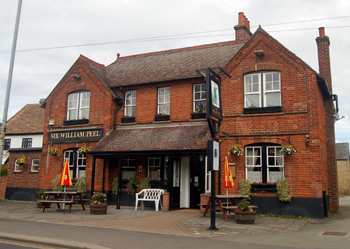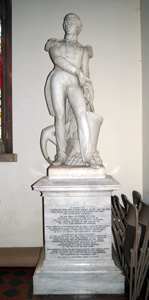The Sir William Peel Public House Sandy

Sir William Peel March 2010
The Sir William Peel Public House: 39 High Street, Sandy [formerly the Lord Nelson]
The name Sir William Peel is a relatively new one, having been bestowed on the public house in 1994 following refurbishment. It refers, of course, to the son of Prime Minister Robert Peel, the Victoria Cross holder who built the railway to Potton and is commemorated by a statue in the church.
The public house began life as the Lord Nelson
Beerhouse. The 1876 countywide licensing register states that this beerhouse was first licensed in 1838. The name came from the Nelson family who were the original owners. The Bedfordshire Historic Environment Record [HER] contains information on the county’s historic buildings and landscapes and summaries of each entry can now be found online as part of the
Heritage Gateway website. The entry for the public house [HER 16447] describes it as of
brick construction with a tile roof and two gable ends on each side of the front elevation. There is a porch located over the area between the gable ends and a number of the windows are sashes.
The beerhouse was owned by E. K. and H. Fordham of Ashwell [Hertfordshire] from 1883 and the deeds to the building now form part of the Whitbread Brewery collection [WB] at Bedfordshire and Luton Archives and Records Service. The first deed is in 1780 when William Nelson of Sandy, blacksmith was admitted to a copyhold cottage, held of the Manor of Sandy Rectory, following the death of his father, William [WB/Fordham4/1/Sandy/LN1]. This William Nelson died in 1833 and the following January his wife Ann and children Elizabeth, Mercy Cross, Mary Ann and Maria were all admitted to the property under his will [WB/Fordham4/1/Sandy/LN4]. At this date the property was described as a messuage and blacksmith’s shop with a close of one acre adjoining it.
In 1845 when the premises was mortgaged it was still not described as a beerhouse but a messuage divided into two tenements with a blacksmith’s shop adjoining [WB/Fordham4/1/Sandy/LN8]. This does not necessarily mean that the date of first licensing ascribed in 1876, it may just as easily be that the description in the court roll was not updated.
In 1857 Mercy Cross’ daughter Lavinia Nelson Cross became sole owner of the property [WB/Fordham4/1/Sandy/LN10] which was then described as a principal dwelling in the occupation of Samuel Dixie, a two roomed dwelling occupied by James and Mary Ann Usher and Elizabeth Nelson, a blacksmith’s and wheelwright’s shop occupied by Judd and a plumber’s shop by Mackaness. Mercy Cross died in 1870 [WB/Fordham4/1/Sandy/LN14] at which point, in the Inland Revenue account the Lord Nelson beerhouse is first mentioned.
In 1883 the Lord Nelson was put up for sale by auction by Lavinia’s executors. The sale was in five lots [WB/Fordham4/1/Sandy/LN16]. Lot 1 was the beerhouse itself, described as plaster and thatched with a new brick front with an adjoining cottage of similar construction. The beerhouse was approached by a large gravel yard and contained a tap room, a bar, a scullery, a cellar and three bedrooms – “it is a free house and has done a very large business”. The main beer suppliers were E. K. and H. Fordham who bought it at the auction for £1,000. The adjoining cottage had two rooms with a lean-to washhouse and was occupied by James Usher.
The property was enfranchised, that is, made freehold in 1896 at the cost of £93/12/8 to Fordhams [WB/Fordham4/1/Sandy/LN27]The countywide register of alehouse licences of 1903 reveals that the nearest licensed house was 52 yards away, that the state of repair of the Lord Nelson was good and that it had two front doors and one back door.
The Rating and Valuation Act 1925 specified that every building and piece of land in the country was to be assessed to determine its rateable value. The valuer visiting the Lord Nelson [DV1/C147/62] found the beerhouse still owned by Fordham & Company of Ashwell and occupied by Charles Edward Butterfield who paid rent of £15 per annum fixed at Christmas 1925.
The brick, tiled and slate, detached property comprised a tap room and smoke room, bar and kitchen with two bedrooms, a lumber room, bathroom and w. c. above. Outside lay a cellar, a wood and felt scullery, a w. c. and urinal, a brick and slate washhouse, garage measuring 13 feet 6 inches by 15 feet and two stall stable. The valuer noted: “Good range of buildings”.
Business consisted of one to one and a half barrels of beer per week. Takings were £12 per week, or £14 per week including sales of tobacco. The tenant also had cars for hire. The valuer commented: “Good draw up, modern building. Good bars”. Another hand has written that the scullery was rebuilt in brick in 1935.
In 1952 E. K. and H. Fordham was bought by Luton brewer J. W. Green Limited and two years later Green merged with Midlands brewer Flowers, the new company taking the Flowers name. The Lord Nelson became a fully licensed public house on 6th March 1957. In 1962 Flowers was taken over by Whitbread. In 2001 Whitbread pulled out of brewing and sold most of its licensed premises. The Sir William Peel, as it has been since 1994 continues to operate as a public house at the time of writing [2010].

Monument to Sir William Peel May 2010
References:
- WB/Fordham4/1/Sandy/LN1: admission: 1780;
- WB/Fordham4/1/Sandy/LN4: admission: 1833;
- WB/Fordham4/1/Sandy/LN8: mortgage: 1845;
- WB/Fordham4/1/Sandy/LN10: admission: 1857;
- WB/Fordham4/1/Sandy/LN14: Inland revenue succession account: 1870;
- HF143/1: Register of Alehouse Licences - Biggleswade Petty Sessional Division: 1872-1873;
- HF143/2: Register of Alehouse Licences - Biggleswade Petty Sessional Division: 1874-1877;
- HF143/3: Register of Alehouse Licences - Biggleswade Petty Sessional Division: 1878-1881;
- HF143/4: Register of Alehouse Licences - Biggleswade Petty Sessional Division: 1882-1890;
- WB/Fordham4/1/Sandy/LN16: sale particulars: 1883;
- HF143/5: Register of Alehouse Licences - Biggleswade Petty Sessional Division: 1891-1900;
- HF76/6/4/1-4 and WB/Fordham4/1/Sandy/LN27]: enfranchisement: 1896
- HF143/6: Register of Alehouse Licences - Biggleswade Petty Sessional Division: 1900-1914;
- PSBW8/1: Register of Alehouse Licences - Biggleswade Petty Sessional Division: 1903-1915;
- X758/1/11 (56-58): poor copy photographs: c. 1920s;
- PSBW8/2: Register of Alehouse Licences - Biggleswade Petty Sessional Division: 1956-1972;
- PSBW8/3: Register of Alehouse Licences - Biggleswade and North Bedfordshire Petty Sessional Divisions: 1976-1980;
- Z898/3: landlord referred to in an oral history transcript: 1995
List of Licensees: note that this is not a complete list. Italics indicate licensees whose beginning and/or end dates are not known:
1870-1883: Lavinia Nelson Cross;
1883-1884: James Braisher;
1884-1888: Jesse Blain;
1888: Thomas Worsley;
1891-1896: Arthur Parsons;
1896-1909: William Parrott, cab and car proprietor;
1909-1911: Henry Woodthorpe;
1911-1924: Frederick William Rust;
1927-1928: Charles Edward Butterfield;
1931: Frederick Gasson;
1936-1940: Frederick Simms;
1957: Laura Simms;
1957-1985: Myer Hyman;
1985: Edith May Hyman;
1985-1987: Stephen Ronald Dipple;
1987-1993: Paul Stephen John Ryan;
1993-1994: Brian Harold Pike and Alice Pike;
1994-1995: Geoffrey John Reeve;
1995: Darren Neil Owen and Michael Charles Barham;
1995-1996: Janet Chambers and Michael Charles Barham;
1996: Glen Aitken and Michael Charles Barham